扩频通信系统的介绍 英文翻译
- 格式:doc
- 大小:114.62 KB
- 文档页数:8
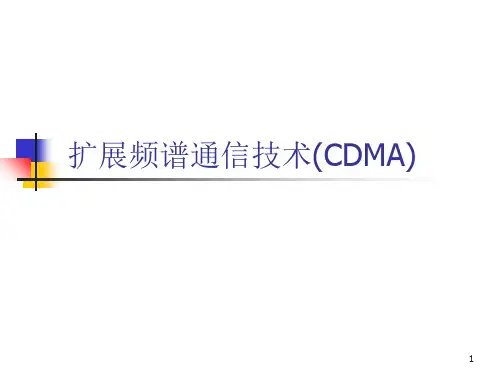
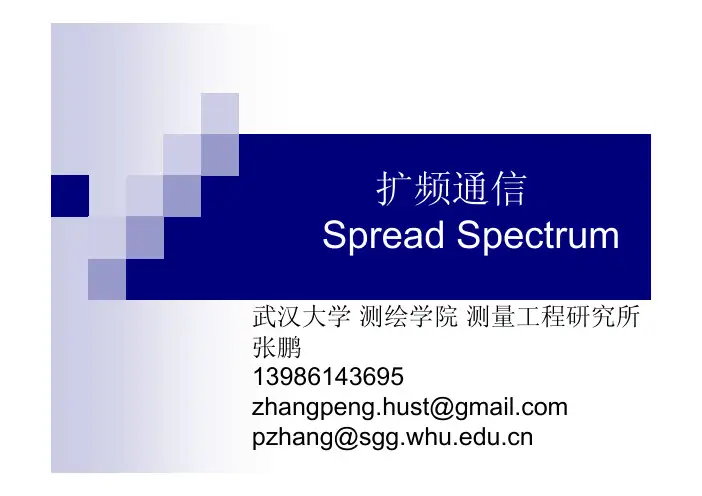
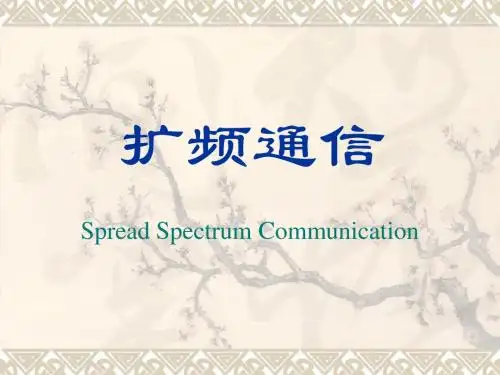
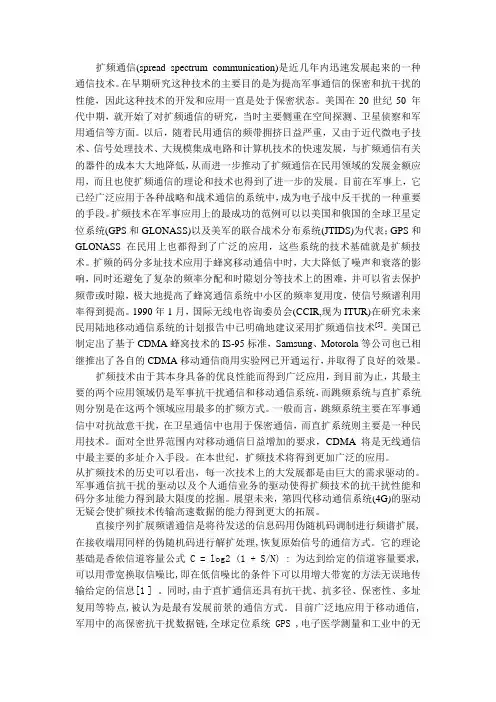
扩频通信(spread spectrum communication)是近几年内迅速发展起来的一种通信技术。
在早期研究这种技术的主要目的是为提高军事通信的保密和抗干扰的性能,因此这种技术的开发和应用一直是处于保密状态。
美国在20世纪50 年代中期,就开始了对扩频通信的研究,当时主要侧重在空间探测、卫星侦察和军用通信等方面。
以后,随着民用通信的频带拥挤日益严重,又由于近代微电子技术、信号处理技术、大规模集成电路和计算机技术的快速发展,与扩频通信有关的器件的成本大大地降低,从而进一步推动了扩频通信在民用领域的发展金额应用,而且也使扩频通信的理论和技术也得到了进一步的发展。
目前在军事上,它已经广泛应用于各种战略和战术通信的系统中,成为电子战中反干扰的一种重要的手段。
扩频技术在军事应用上的最成功的范例可以以美国和俄国的全球卫星定位系统(GPS和GLONASS)以及美军的联合战术分布系统(JTIDS)为代表;GPS和GLONASS在民用上也都得到了广泛的应用,这些系统的技术基础就是扩频技术。
扩频的码分多址技术应用于蜂窝移动通信中时,大大降低了噪声和衰落的影响,同时还避免了复杂的频率分配和时隙划分等技术上的困难,并可以省去保护频带或时隙,极大地提高了蜂窝通信系统中小区的频率复用度,使信号频谱利用率得到提高。
1990年1月,国际无线电咨询委员会(CCIR,现为ITUR)在研究未来民用陆地移动通信系统的计划报告中已明确地建议采用扩频通信技术[5]。
美国已制定出了基于CDMA蜂窝技术的IS-95标准,Samsung、Motorola等公司也已相继推出了各自的CDMA移动通信商用实验网已开通运行,并取得了良好的效果。
扩频技术由于其本身具备的优良性能而得到广泛应用,到目前为止,其最主要的两个应用领域仍是军事抗干扰通信和移动通信系统,而跳频系统与直扩系统则分别是在这两个领域应用最多的扩频方式。
一般而言,跳频系统主要在军事通信中对抗故意干扰,在卫星通信中也用于保密通信,而直扩系统则主要是一种民用技术。

An Introduction to Spread-Spectrum CommunicationsAbstract:This application note is a tutorial overview of spread-spectrum principles.The discussion covers both direct-sequence and fast-hopping methods.Theoretical equations are given to allow performance estimates.The following discussion of direct-sequence spread-spectrum(DSSS) and frequency-hopping spread-spectrum(FHSS) methods.As spread-spectrum techmiques become increasingly popular,electrical engineers outside the field are eager for understandable explanations of the technology.There are books and websites on the subject,but many are hard to understand or describe some aspects while ignoring others(e.g.,the DSSS technique with extensive focus on PRN-code generation).The following discussion covers the full spectrum.1.A Short HistorySpread-spectrum communications technology was first described on paper by an actress and a musician!In 1941 Hollywood actress Hedy Lamarr and pianist George Antheil described a secure radio link to control torpedos.They received U.S.Patent #2.292.387.The technology was not taken seriously at that time by the U.S.Army and was forgotten until the 1980s,when it became active.Since then the technology has become increasingly popular for application that involve radio links in hostile environments.Typical applications for the resulting short-range data transceivers include satellite-positioning systemsGPS,3G mobile telecommunications,W-LAN(IEEE®802.11a,IEEE 802.11b,IEEE 802.11g),and Bluetooth®.Spread-spectrum techniques also aid in the endless race between communication needs and radio-frequency availability-situations where the radio spectrum is limited and is,therefore,an expensive resource.2.Theoretical Justification for Spread SpectrumSpread-spectrum is apparent in the Shannon and Hartley channel-capacity theorem: C=B×log2(1+S/N) (Eq.1)I n this equation,C is the channel capacity in bits per second(bps),which is the maximum data rate for a theoretical bit-error rate(BER).B is the required channel bandwidth in Hz,and S/N is the signal-to-nosie power ratio.To be more explicit,one assumes that C,which represents the amount of information allowed by the communication channel,also represents the desired performance.Bandwidth (B) is the price to be paid,bacause frequency is a limited resource.The S/N ratio expresses the environmental conditions or the physical characteristics (i.e., obstacles ,presence of jammers ,interferences,etc.).There is an elegant interpretation of this equation,applicable for difficult environments,forexample,when a low S/N ratio is caused by noise and interference.This approach says that one can maintain or even increase communication performance (high C) by allowing or injecting more bandwidth (high B),even when signal power is below the noise floor. (The equation does not forbid that condition!)Modify Equation 1 by changing the log base from 2 to e (the Napierian number) and by noting that In=loge.Therefore:C/B=(1/ln2)×ln(1+S/N)=1.443×ln(1+S/N) (Eq.2)Applying the MacLaurin series development forln(1+x)=x-x2/2+x3/3-x4/4+…+(-1)k+1xk/k+…:C/B=1.443×(S/N-1/2×(S/N)2+1/3×(S/N)3-…) (Eq.3)S/N is usually low for spread-spectrum applications. (As just mentioned, the signal power density can even be below the noise level.) Assuming a noise level such that S/N <<1,Shannon's expression becomes simply:C/B≈1.443×S/N (Eq.4)Very roughly:C/N≈S/N (Eq.5)Or:N/S≈B/C (Eq.6)To send error-free information for a given noise-to-signal ratio in the channel,therefore,one need only perform the fundamental spread-spectrum signal-spreading operation:increase the transmitted bandwidth.That principle seems simple and evident.Nonetheless,implementation is complex,mainly because spreading the baseband (by a factor that can be several orders of magnitude) forces the electronics to act and react accordingly,which,in turn,makes the spreading and despreading operations necessary.3.Spread Spectrum definitionsDifferent spread-spectrum techniques are available,but all have one idea in common:the key (also called the code or sequence) attached to the communication channel.The manner of inserting this code defines precisely the spread-spectrum technique.The term "spread spectrum" refers to the expansion of signal bandwidth,by several orders of magnitude in some cases,which occurs when a key is attached to the communication channel.The formal definition of spread spectrum is more precise:an RF communications system in which the baseband signal bandwidth is intentionally spread over a larger bandwidth by injecting a higher frequency signal (Figure 1).As a direct consequence,energy used in transmitting the signal is spread over a wider bandwidth,and appears as noise.The ratio (in dB) between thespread baseband and the original signal is called processing gain.Typical spread-spectrum processing gains run from 10dB to 60dB.To apply a spread-spectrum technique,simply inject the corresponding spread-spectrum code somewhere in the transmitting chain before the antenna (receiver).Conversely,you can remove the spread-spectrum code (called a despreading operation) at a point in the receive chain before data retrieval.A despreading operation reconstitutes the information into its original bandwidth.Obviously,the same code must be known in advance at both ends of the transmission channel. (In some circumstances,the code should be known only by those two parties).Therefore, the impact caused by the bandwidth of the following:Figure 1.Spread-spectrum communication system(1)Bandwidth Effects of the Spreading OperationFigure 2 illustrates the evaluation of signal bandwidths in a communication link.Figure 2.Spreading operation spreads the signal energy over a wider frequency bandwidth.Spread-spectrum modulation is applies on top of a conventional modulation such as BPSK or direct conversion.One can demonstrate that all other signals not receiving the spread-spectrum code will remain ad they are,that is,unspread.(2)Bandwidth Effects of the Despreading OperationSimilarly,despreading can be seen in Figure 3.Figure 3. The despreading operation recovers the original signal.Here a spread-spectrum demodulation has been made on top of the normal demodulation operations.One can also demonstrate that signals such as an interferer or jammer added during the transmission will be spread during the despreading operation! (3)Waste of Bandwidth Due to Spreading Is Offset by Multiple UsersSpreading results directly in the use of a wider frequency band by a factor that corresponds exactly to the "processing gain" mentioned earlier.Therefore spreading does not spare the limited frequency resource.That overuse is well compensated,however,by the possibility that many users will share the enlarged frequency band (Figure 4).Figure 4. The same frequency band can be shared by multipleusers with spread-spectrum techniques.4.Spread Spectrum Is a Wideband TechnologyIn contrast to regular narrowband technology,the spread-spectrum process is a wideband technology.For example,W-CDMA and UMTS,are wideband technologies that require a relatively large frequency bandwidth, compared to narrowband radio.Benefits of Spread Spectrum:(1) Resistance to Interference and Antijamming EffectsThere are many benefits to spread-spectrum technology.Resistance to interference is the most important advantage.Intentional or unintentional interference and jamming signals are rejected because they do not contain the spread-spectrum key.Only the desired signal,which has the key, will be seen at the receiver when the despreading operation is exercised.See Figure 5.Figure 5. A spread-spectrum communication system.Note that the interferer’s energy is spread while the data signal is despread in the receive chain.You can practically ignore the interference,narrowband or wideband,if it does not include the key used in the dispreading operation.That rejection also applies to other spread-spectrum signals that do not have the right key.Thus different spread-spectrum communications can be active simultaneously in the same band,such as CDMA.Note that spread-spectrum is a wideband technology,but the reverse is not true:wideband techniques need not involve spread-spectrum technology.(2) Resistance to InterceptionResistance to interception is the second advantage provided by spread-spectrum techniques.Because nonauthorized listeners do not have the key used to spread the original signal,those listeners cannot decode it.Without the right key,the spread-spectrum signal appears as noise or as an interferer.(Scanning methods can break the code,however,if the key is short.) Even better,signal levels can be below the noise floor,because the spreading operation reduces the spectral density.See Figure 6.(Total energy is the same,but it is widely spread in frequency.) The message is thus made invisible,an effect that is particularly strong with the direct-sequence spread-spectrum (DSSS) technique.(DSSS is discussed in greater detail below.) Other receivers cannot “see” the transmission;they only register a slight increase in the overall noise level!Figure 6.Spread-spectrum signal is buried under noise level.The receiver cannot “see”the transmission without the right spread-spectrum keys.(3) Resistance to Fading (Multipath Effects)Wireless channels often include multiple-path propagation in which the signal has more than one path from the transmitter to the receiver (Figure 7).Such multipaths can be caused byatmospheric reflection or refraction, and by reflection from the ground or from objects such as buildings.Figure 7.Illustration of how the signal can reach the receiver over multiple paths.The reflected path (R) can interfere with the direct path (D) in a phenomenon called fading.Because the dispreading process synchronizes to signal D,signal R is rejected even though it contains the same key. Methods are available to use the reflected-path signals by dispreading them and adding the extracted results to the main one.5.Spread Spectrum Allows CDMANote that spread spectrum is not a modulation scheme,and should not be confused with other types of modulation.One can,for example,use spread-spectrum techniques to transmit a signal modulated by PSK or BPSK.Thanks to the coding basis,spread spectrum can also be used as another method for implementing multiple access (i.e.,the real or apparent coexistence of multiple and simultaneous communication links on the same physical media).So far,three main methods are available.a.FDMA-Frequency Division Multiple AccessFDMA allocates a specific carrier frequency to a communication channel.The number of different users is limited to the number of “slices” in the frequency spectrum (Figure 8).Of the three methods for enabling multiple access,FDMA is the least efficient in term of frequency-band usage.Methods of FDMA access include radio broadcasting,TV,AMPS,and TETRAPOLE.Figure 8.Carrier-frequency allocations among different users in a FDMA system.b.TDMA-Time Division Multiple AccessWith TDMA the different users speak and listen to each other according to a defined allocation of time slots (Figure 9).Different communication channels can then be established for a unique carrier frequency.Examples of TDMA are GSM,DECT,TETRA,and IS-136.Figure 9. Time-slot allocations among different users in a TDMA system.c.CDMA-Code Division Multiple AccessCDMA access to the air is determined by a key or code (Figure 10).In that sence,spread spectrum is a CDMA access.The key must be defined and known in advance at the transmitter and receiver ends.Growing examples are IS-95 (DS),IS-98,Bluetooth,and WLAN.Figure 10.CDMA systems access the same frequency band with unique keys or codes.One can,of course,combine the above access methods.GSM,for instance,combines TDMA and FDMA.GSM defines the topological areas (cells) with different carrier frequencies,and sets time slots within each cell.6.Spread Spectrum and coding “Keys”At this point,it is worth restating that the main characteristic of spread spectrum is the presence of a code or key,which must be known in advance by the transmitter and receiver (s).In modern communications the codes are digital sequences that must be as long and as random as possible to appear as “noise-like”as possible.But in any case,the codes must remain reproducible.or the receiver cannot extract the message that has been sent.Thus,the sequence is “nearly random”.Such a code is called a pseudo-random number (PRN) or sequence.The method most frequently used to generate pseudo-random codes is based on a feedback shift register.Many books are available on the generation of PRNs and their characteristics,but that development is outside the scope of this basic tutorial.Simply note that the construction orselection of proper sequences,or sets of sequences,is not trivial.To guarantee efficient spread-spectrum communications,the PRN sequences must respect certain rules,such as length, autocorrelation,cross-correlation,orthogonality,and bits balancing.The more popular PRN sequences have names:Barker,M-Sequence,Gold,Hadamard-Walsh,etc.Keep in mind that a more complex sequence set provides a more robust spread-spectrum link.But there is a cost to this: more complex electronics both in speed and behavior,mainly for the spread-spectrum despreading operations.Purely digital spread-spectrum despreading chips can contain more than several million equivalent 2-input NAND gates,switching at several tens of megahertz.。
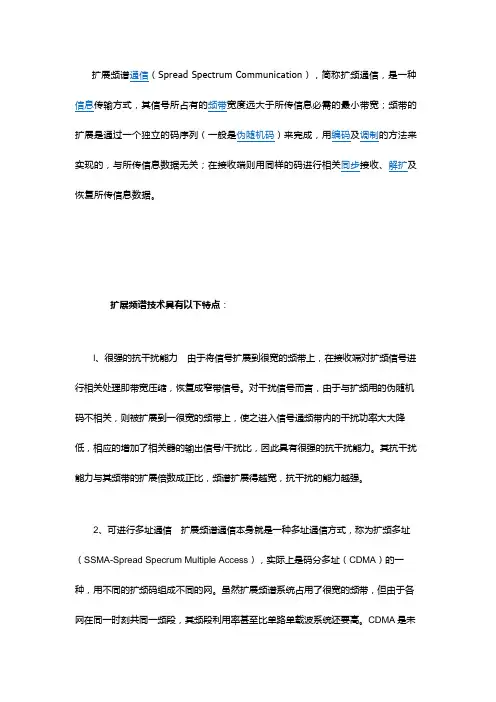
扩展频谱通信(Spread Spectrum Communication),简称扩频通信,是一种信息传输方式,其信号所占有的频带宽度远大于所传信息必需的最小带宽;频带的扩展是通过一个独立的码序列(一般是伪随机码)来完成,用编码及调制的方法来实现的,与所传信息数据无关;在接收端则用同样的码进行相关同步接收、解扩及恢复所传信息数据。
扩展频谱技术具有以下特点:l、很强的抗干扰能力由于将信号扩展到很宽的频带上,在接收端对扩频信号进行相关处理即带宽压缩,恢复成窄带信号。
对干扰信号而言,由于与扩频用的伪随机码不相关,则被扩展到一很宽的频带上,使之进入信号通频带内的干扰功率大大降低,相应的增加了相关器的输出信号/干扰比,因此具有很强的抗干扰能力。
其抗干扰能力与其频带的扩展倍数成正比,频谱扩展得越宽,抗干扰的能力越强。
2、可进行多址通信扩展频谱通信本身就是一种多址通信方式,称为扩频多址(SSMA-Spread Specrum Multiple Access),实际上是码分多址(CDMA)的一种,用不同的扩频码组成不同的网。
虽然扩展频谱系统占用了很宽的频带,但由于各网在同一时刻共同一频段,其频段利用率甚至比单路单载波系统还要高。
CDMA是未来全球各人通信的一种主要的多址通信方式。
3、安全保密由于扩频系统将传送的信息扩展到很宽的频带上去,其功率密度随频谱的展宽而降低,甚至可以将通信信号淹没在噪声中。
因此,其保密性很强,要截获或窃听、侦察这样的信号是非常困难的,除非采用与发送端所用的扩频码且与之同步后进行相关的检测,否则对扩频信号是无能为力的。
由于扩频信号功率谱密度很低,在许多国家,如美、日、欧洲等国家对专用频段,如ISM频段,只要功率谱密度满足一定的要求,就可以不经批准使用该频段。
4、抗多径干扰在移动通信、室内通信等通信环境下,多径干扰是非常严重的,系统必须具有很强的抗干扰的能力,才能保证通信的畅通。
扩展频谱技术具有很强的抗多径能力,它是利用利用扩频所用的扩频码的相关特性来达到抗多径干扰,甚至可以利用多径能量来提高系统的性能。
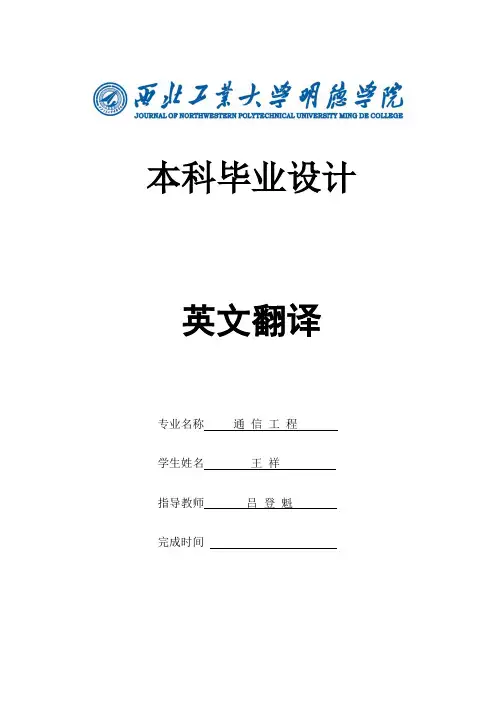
本科毕业设计英文翻译专业名称通信工程学生姓名王祥指导教师吕登魁完成时间本科毕业设计英文翻译指导教师评阅意见学生姓名:班级:得分:请指导教师用红笔在译文中直接进行批改,并就以下几方面填写评阅意见,给出综合得分(满分按15分计)。
1、专业术语、词汇翻译的准确性;2、翻译材料是否与原文的内容一致;3、翻译材料字数是否符合要求;4、语句是否通顺,是否符合中文表达习惯。
指导教师(签名):年月日扩频通信系统的介绍摘要:本应用笔记概述了扩频技术的原理,讨论了涵盖直接序列和快速跳频的方法。
相关理论方程的性能估算。
以及讨论直接序列扩频(DSSS )和跳频(FHSS )这两种扩频方式。
简介扩频技术越来越受欢迎,就连这一领域以外的电器工程师都渴望能够深入理解这一技术。
很多书和网站上都有关于这方面的书,但是,很多都很难理解或描述的不够详尽。
(例如,直接序列扩频技术广泛关注的是伪随机码的产生)。
定义不同的扩频技术都有一个共同之处:密钥(也称为代码或序列)依附于传输信道。
以插入代码的形式准确地定义扩频技术,术语“频谱扩展”是指扩频信号的几个数量级的带宽在有密钥的传输信道中的扩展。
以传统的方式定义扩频更为精确:在射频通信系统中,将基带信号扩展为比原有信号的带宽宽得多的高频信号(如图1)。
在此过程中,传输宽带信号产生的损耗,表现为噪声。
扩频信号带宽与信息带宽之比称为处理增益。
扩频过程的处理增益大都在10dB 到60dB 之间。
扩频的优点抗干扰性能和抗干扰的影响扩频技术有很多优点。
抗干扰性是最重要的一个优点。
有意或无意的干扰和干扰信号都是不希望存在的因为它们不包含扩频密钥。
只有期望信号才有密钥,在解扩过程中才会被接收器接收,如图5。
图5:扩频通信系统(注意,解扩链路中数据信号被传输的同时干扰能源也被传输) 输电链扩频代接收链 扩频代码数据输入射频输出射频输入 RF IN 射频连接 数据输出 数据 干扰 数据扩展和干扰扩展数据扩展 数据扩展和干扰无论在窄带或宽带中,如果它不涉及解扩过程,你几乎可以忽略干扰。
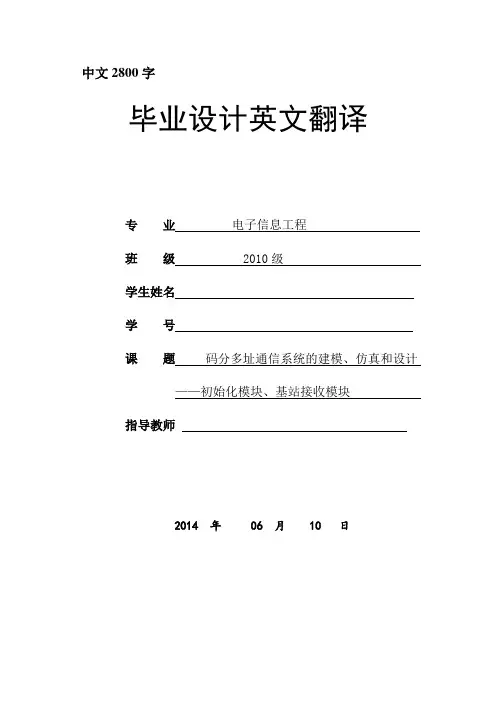
中文2800字毕业设计英文翻译专业电子信息工程班级2010级学生姓名学号课题码分多址通信系统的建模、仿真和设计——初始化模块、基站接收模块指导教师2014 年06 月10 日译文原文1.1 The basic concept of spread-spectrum communicationSpread spectrum communication’s basic characteristics, is used to transmit information to the signal bandwidth(W) is far greater than practical required minimum(effective) bandwidth (F∆),as the radio of processing gain P G.=/G P∆FWAs we well know,the ordinary AM,FM,or pulse code modulation,GP value in the area more than 10 times,collectively,the “narrow-band communication”,and spread-spectrum communication GP values as hundred or even thousands of times, can be called “broadband communication”.Due to the spread-spectrum signal,it is very low power transmitters,transmission space mostly drowned in the noise,it is difficult to intercepted by the other receiver ,only spreading codes with the same (or random PN code) receiver, Gain can be dealt with ,and despreading resume the original signal.1.2 The technology superiority of spread-spectrum communication.Strong anti-interference, bit error rate is low. As noted above, the spread spectrum communication system due to the expansion of the transmitter signal spectrum, the receiver despreading reduction signal produced spreading gain, thereby greatly enhancing its interference tolerance. Under the spreading gain, or even negative in the signal-to-noise ratio conditions, can also signal from the noise drowned out Extraction, in the current business communications systems, spread spectrum communications systems, spread spectrum communication is only able to work in a negative signal-to-noise ratio under the conditions of communication .Anti-multi-path interference capability, increase the reliability of system. Spread-spectrum systems as used in the PN has a good correlation, correlation is very weak. Different paths to the transmission signal can easily be separated and may intime and re-alignment phase, formation of several superimposed signal power, thereby improving the system’s performance to receive increased reliability of the system.Easy to use the same frequency, improving the wireless spectrum utilization. Wireless spectrum is very valuable,although long-wave microwave have to be exploited, and still can not meet the needs of community. To this end, countries around the world are designed spectrum management, users can only use the frequency applications,rely on the channel to prevent the division between the channel interference.Due to the use of spread-spectrum communication related receive this high-tech,low signal output power(“a W,as a general-100mW),and will work in the channel noise and thermal noise in the background,easy to duplicate in the same area using the same frequency,can now all share the same narrow-band frequency communication resources.Spread-spectrum communication is digital communication,particularly for digital voice and data transmission with their own encryption, only in the same PN code communication between users, is good for hiding and confidential in nature, facilitating communication business. Easy to use spread-spectrum CDMA communications, voice compression and many other new technologies, more applicable to computer networks and digitization of voice,image information transmission.Communication in the most digital circuits, equipment, highly integrated, easy installation, easy maintenance, but also very compact and reliable. The average failure rate no time was very long.1.3 Spread spectrum communication systemSpread spectrum communication,namely, spread spectrum communications (Spread spectrum communication), with fiber-optic communications,satellite communications,with access to the information age as the three major high-tech communications transmission. Spread spectrum communication is to send the information to be pseudo-random data is coded(Spread spectrum sequence: spread sequence) modulation, spread spectrum and then the realization of transmission; thereceiving end is using the same modem code and related processing, the restoration of the original data. Spread spectrum communication system has three main characteristics.(1) Carrier is an unpredictable, or so-called pseudo-random broadband signal.(2) Carrier data bandwidth than the modulation bandwidth is much wilder.(3) Receiving process is generated by local broadband carrier signal and receiving a copy of the signal to the broadband signal to achieve.The main way of spread spectrum are as follows: Direct Sequence Spread Spectrum(DSSS) using high-speed pseudo-random code on to the low-speed data transmission spread spectrum modulation; Frequency-hopping system using pseudo-random code to control the carrier frequency in a wider band of the change; TH is the data transmission time slot is a pseudo-random; chirp frequency system is a linear extension of the process of change. Combination of a number of ways of hybrid systems are often applied.The most important measure pf spread-spectrum system is an indicator of spreading gain, also known as processing gain. It is precisely because of the spread spectrum system itself with its performance characteristics with a series of advantages.1.4 Code division multiple accessCode division multiple access (CDMA) is a channel access method used by various radio communication technologies. It should not be confused with the mobile phone standards called cdmaOne, CDMA2000(the 3G evolution of cdmaOne) and WCDMA (the 3Gstandard used by GSM carrier), which are often referred to as simply CDMA, and use CDMA as an underlying channel access method.One of the concepts in data communication is the idea of allowing several transmitters to send information simultaneously over a signal communication channel. This allows several users to share a band of frequencies (see bandwidth). This concept is called multiple access. CDMA employs spread-spectrum technology and a special coding scheme( where each transmitter is assigned a code) to allow multiple user to be multiplexed over the same physical channel. By contrast, time division multipleaccess (FDMA) divides it by frequency. CDMA is a form of spread-spectrum signaling, since the modulated coded signal has a much higher data bandwidth than the data being communicated.1.5 Spread-spectrum characteristic of CDMAMost modulation schemes try to minimize the bandwidth of this signal since bandwidth is a limited resource. However, spread spectrum use a transmission bandwidth that is several orders of magnitude greater than the minimum required signal bandwidth. One of the initial reasons for doing this was military applications including guidance and communication systems. These system were designed using spread spectrum because if its security and resistance to jamming. Asynchronous CDMA has some level of privacy built in because the signal is spread using a pseudo-random code; this code makes the spread spectrum signals appear random or have noise-like properties. A receiver cannot demodulate this transmission without knowledge of the pseudo-random sequence used to encode the data. CDMA also resistant to jamming. A jamming signal only has a finite amount of power available to jam the signal. The jammer can either spread its energy over the entire bandwidth of the signal or jam only part of the entire signal.CDMA can also effectively reject narrow band interference. Since narrow band interference affects only a small portion of the spread spectrum signal, it can easily be removed through notch filtering without much loss of information. Convolution encoding and interleaving can be used to assist in recovering this lost data. CDMA signal are also resistant to multipath fading. Since the spread spectrum signal occupies a large bandwidth only a small portion of this will undergo fading due to multipath at any give time. Like the narrow band interference this will result in only a small loss of data and can be overcome.Another reason CDMA is resistant to multipath interference is because the delayed versions of the transmitted pseudo-random code, and will thus appear as another user, which is ignored at the receiver. In other words, as long as the multipath channel induces at least one chip of delay, 天the multipath channel induces at least one chip of delay,the multipath signals will arrive at the receiver.in other words, as long as the multipath channel induces at least one chip of delay, the multipath signalswill arrive at the receiver such that they are shifted in time by at least one chip from the intended signal. The correlation properties of the pseudo-random codes are such that this slight delay causes the multipath to appear uncorrelated with the intended signal, and it is thus ignored.Some CDMA devices use a rake receiver, which exploits multipath delay components to improve the performance of the system. A rake receiver combines the information from several correlators, each one tuned to a different path delay, producing a stronger version of the signal than a simple receiver with a signal correlation tuned to the path delay of the strongest signal.Frequency reuse is the ability to reuse the same radio channel frequency at other cell sites within a cellular system. In the FDMA and TDMA systems frequency planning is and important consideration. The frequencies used in different cells must be planned carefully to ensure signals from different cells do not interfere with each other. In a CDMA system, the same frequency can be used in every cell, because channelization is done using the pseudo-random codes. Reusing the same frequency in every cell eliminates the need for frequency planning in a CDMA system; however, planning of the different pseudo-random sequences must be done to ensure that the received signal from one cell does not correlate with the signal from a nearby cell.Since adjacent cell use the same frequencies, CDMA systems have the ability to perform soft handoffs. Soft handoffs allow the mobile telephone to communication simultaneously with two or more cells. The best signal quality in selected until the handoff is complete. This is different from hard handoffs utilized in other cellular systems. In a hard handoff situation, as the mobile telephone approaches a handoff, signal strength may vary abruptly. In contrast, CDMA systems use the soft handoff, which is undetectable and provides a more reliable and higher quality signal.Concluding remarksspread-spectrum technology in the initial stages of development, it has become a theory and a major technological breakthrough. Later in the development process is the improvement and hardware performance improved. Development to thepresent,spread-spectrum technology and the theory has been almost perfect,mainly from the point of view of overall performance, and the other new technology applications. Therefore, the application has been driven by the development of spread-spectrum technology is a power driving force, the future wireless communication systems, such as mobile communication. Wireless LAN, global personal communications, spread-spectrum technology will certainly play an important role.译文正文1.扩频通信系统概述扩频通信,即扩展频谱通信(Spread spectrum communication),它与光纤通信、卫星通信,一同誉为进入信息时代的三大高技术通信传输方式,扩频通信是将待传送的信息数据被伪随机码调制,实现频谱扩展后再传输;接收端则采用相同的编码进行解调及相关处理,恢复原始信息数据。
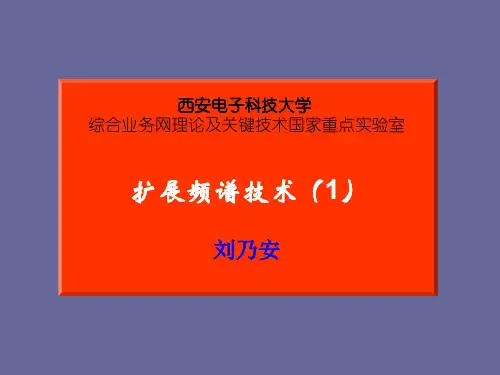
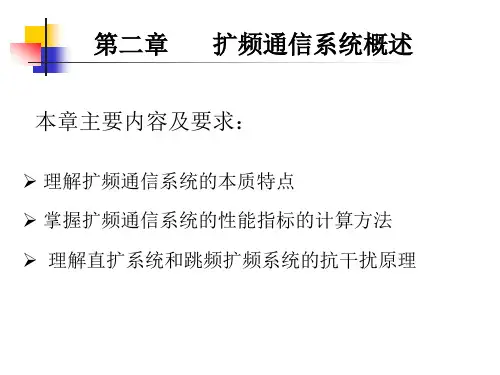
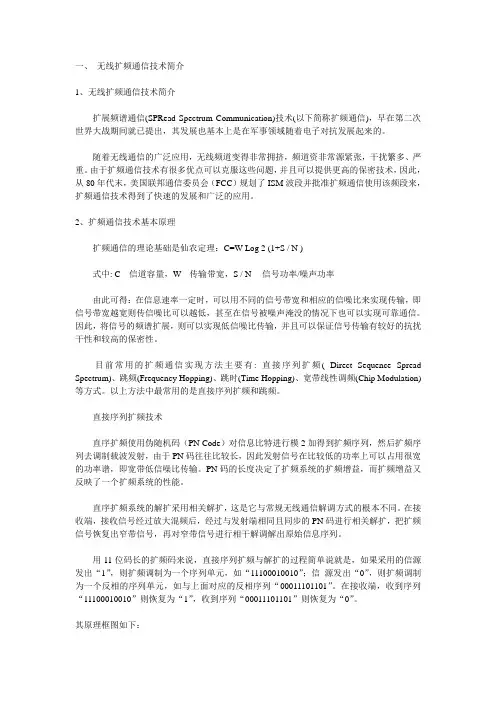
一、无线扩频通信技术简介1、无线扩频通信技术简介扩展频谱通信(SPRead Spectrum Communication)技术(以下简称扩频通信),早在第二次世界大战期间就已提出,其发展也基本上是在军事领域随着电子对抗发展起来的。
随着无线通信的广泛应用,无线频道变得非常拥挤,频道资非常源紧张,干扰繁多、严重。
由于扩频通信技术有很多优点可以克服这些问题,并且可以提供更高的保密技术,因此,从80年代末,美国联邦通信委员会(FCC)规划了ISM波段并批准扩频通信使用该频段来,扩频通信技术得到了快速的发展和广泛的应用。
2、扩频通信技术基本原理扩频通信的理论基础是仙农定理:C=W Log 2 (1+S / N )式中: C---信道容量,W---传输带宽,S / N ---信号功率/噪声功率由此可得:在信息速率一定时,可以用不同的信号带宽和相应的信噪比来实现传输,即信号带宽越宽则传信噪比可以越低,甚至在信号被噪声淹没的情况下也可以实现可靠通信。
因此,将信号的频谱扩展,则可以实现低信噪比传输,并且可以保证信号传输有较好的抗扰干性和较高的保密性。
目前常用的扩频通信实现方法主要有: 直接序列扩频( Direct Sequence Spread Spectrum)、跳频(Frequency Hopping)、跳时(Time Hopping)、宽带线性调频(Chip Modulation)等方式。
以上方法中最常用的是直接序列扩频和跳频。
直接序列扩频技术直序扩频使用伪随机码(PN Code)对信息比特进行模2加得到扩频序列,然后扩频序列去调制载波发射,由于PN码往往比较长,因此发射信号在比较低的功率上可以占用很宽的功率谱,即宽带低信噪比传输。
PN码的长度决定了扩频系统的扩频增益,而扩频增益又反映了一个扩频系统的性能。
直序扩频系统的解扩采用相关解扩,这是它与常规无线通信解调方式的根本不同。
在接收端,接收信号经过放大混频后,经过与发射端相同且同步的PN码进行相关解扩,把扩频信号恢复出窄带信号,再对窄带信号进行相干解调解出原始信息序列。
扩展频谱通信(Spread Spectrum Communication)简称扩频通信,其特点是传输信息所用的带宽远大于信息本身带宽。
扩频通信技术在发端以扩频编码进行扩频调制,在收端以相关解调技术收信,这一过程使其具有诸多优良特性。
1.什么是扩频技术扩频技术,它是一种信息传输方式,其信号所占有的频带宽度远大于所传信息必需的最小带宽;频带的展宽是通过编码及调制的方法实现的,并与所传信息数据无关;在接收端则用相同的扩频码进行相关解调来解扩及恢复所传信息数据。
扩频技术包括以下几种方式:直接序列扩展频谱,简称直扩(DS),跳频(FH),跳时(TH),线性调频(Chirp)。
此外,还有这些扩频方式的组合方式,如FH/DS、TH/DS、FH/TH等。
在通信中应用较多的主要是DS、FH和FH/DS。
2.扩频技术分类1、直扩系统(DS)就是采用高码速率的直接序列(Direct Sequence)伪随机码在发端进行扩频,在收端采用相同的伪码(PN)进行相关解扩。
2、跳频系统(FH)就是采用跳频(FrequencyHopping)方式进行扩频,形象地说是采用特定的伪码控制的多频率移频键控。
3、跳时系统(TH)就是采用跳时(TimeHopping)方式进行扩频,形象地说是采用特定的伪码控制的多时片的时移键控。
4、混合系统就是直扩,跳频和跳时的相应组合即DS/FH/TH混合系统。
3.扩频技术的优缺点优点(1)抗干扰性能好,它具有极强的抗人为宽带干扰、窄带瞄准式干扰、中继转发式干扰的能力,有利于电子反对抗。
如果再采用自适应对消、自适应天线、自适应滤波,可以使多径干扰消除,这对军用和民用移动通信是很有利的。
(2)隐蔽性强、干扰小,因信号在很宽的频带上被扩展,单位带宽上的功率很小,即信号功率谱密度很低。
信号淹没在白噪声之中,难以发现信号的存在,再加上扩频编码,就更难拾取有用信号。
扩频通信技术把被传送的信号带宽展宽,从而降低了系统在单位频宽内的电波“通量密度”,这对空间通信大有好处。
扩频通信结课作业姓名:刘德福班级:通信101学号:10426052扩频技术【摘要】扩频通信,即扩展频谱通信(Spread Spectrum Communication),它与光纤通信、卫星通信一同被誉为进入信息时代的三大高技术通信传输方式。
扩频技术最大的特点是利用宽频带来传输信号。
由于扩频系统具有许多优点,如抗干扰能力强、截获概率低和保密性强以及良好的码分多址通信能力,所以扩频技术已被广泛应用。
CDMA就是利用扩频技术发展起来的一种扩频通信方式,它具有容量大,通信质量好,节约发射功率等优点。
文章试就一些扩频通信的原理及中CDMA采用的扩频技术作些讨论,此外也简单介绍了一些扩频通信在其他方面的应用。
【关键词】扩频通信码分多址(CDMA)多载波调制技术(OFDM)一、引言随着个人通信业务的发展以及全球定位系统的应用,到现在为止,使用扩频技术的用户已经超过一亿。
无线通信已经成为电信产业最大的部门之一,经过十年多的稳步发展,俨然是21世纪中最有发展潜力的领域。
扩频技术在未来无线系统中的应用也再次成为人们关注的重点。
为了更好地把握扩频技术在无线通信中的应用,本文介绍了扩频技术的基本情况、历史、应用,展望。
二、扩频技术扩频通信系统具备三个主要特征:1.载波是一种不可预测的,或称之为伪随机的宽带信号。
2.载波的带宽比调制数据的带宽要宽得多。
3.接收过程是通过将本地产生的宽带载波信号的复制信号与接收到的宽带信号相关来实现的。
频谱扩展的方式主要有以下几种:直序扩频使用高速伪随机码对要传输的低速数据进行扩频调制;跳频系统则利用伪随机码控制载波频率在一个更宽的频带内变化;跳时则是数据的传输时隙是伪随机的;线性调频系统中的频率扩展则是一个线性变化的过程。
几种方式组合的混合系统也经常得到应用。
衡量扩频系统最重要的一个指标就是扩频增益,又称为处理增益。
正是因为扩频系统本身具有的特征使其性能具有一系列的优势:1.低截获概率;2.抗干扰能力强;3.高精度测距;4.多址接入;5.保密性强。
外文资料Pseudorandom Noise SequencesDirect sequence(DS). Direct-sequence spread spectrum(DS-SS) is produced when a bipolar data-modulated signal is linearly multiplied by the spreading signal in a special balanced modulator called a spreading correlator .The spreading code rate R cw=1/T c,where T c is the duration of a single bipolar pulse(i,e., the chip). Chip rates are 100 to 1000 times faster than the data message,therefore,chip times are 100 to 1000 times shorter in duration than the time of a single data bit. As a result, the transmitted output frequency spectrum using spread spectrum is 100 to 1000 times wider than the bandwidth of the initial PSK data-modulated signal.The spreading codes used in spread-spectrum systems are either maximal-length sequence codes, sometimes called m-sequence codes, or Gold codes. Gold codes are combinations of maximal-length codes invented by Magnavox Corporation in 1967 especially for multiple-access CDMA applications .There is a relatively large set of Glod codes available with minimal correlation between chip codes.For a reasonable number of satellite users,it is impossible to achieve perfectly orthogonal codes.You can only design for a minimum cross correlation among chips.One of the advantages of CDMA was that the entire bandwidth of a satellite channel or system may be used for each transmission from every earth station. For our example, the chip rate was six times the original bit rate. Consequently, the actual transmission rate of information was one-sixth of the PSK modulation rate,and the bandwidth required is six times that required to simply transmit the original data as binary. Because of the coding inefficiency resulting from transmitting chips for bits, the advantage of more bandwidth is partially offset and is, thus, less of an advantage. Also, if the transmission of chips from various earth station must be synchronized, precise timing is required for the system to work. Therefore, the disadvantage of requiring time synchronization in TDMA systems is also present with CDMA. In short, CDMA is not all that it is cracked up to be.The most significant advantage of CDMA is immunity to interference, which makes CDMA ideally suited for military applicationsPseudorandom Noise SequencesPN squences are not random; they are deterministic, periodic sequences. The following are the three key properties of an ideal PN sequence:1.The relative frequencies of 0 and 1 are each 1/2.2.The run length(of 0s or 1s)are: 1/2 of all run lengths are of length 1; 1/4are of length 2;1/8 are of length 3; and so on.3.If a PN sequence is shifted by any nonzero number of elements, theresulting sequence will have an equal number of agreements and disagreements with respect to the original sequence.PN sequence are generated by combining the outputs of feedback shift registers. A feedback shift register consists of consecutive two-stage memory or storage stages and feedback lobic. Binary sequences are shifted register in response to clock pulses. The contents of the stages are olgically combined to produce the input to the first stage. The initial contents of the stages and feedback olgic determine the successive contents of the stages. A feedback shift register and its output are called linear when the feedback logic consists entirely of modulo-2 adders.To demonstrate the properties of a PN a binary sequence, we consider a linear feedback shift register(see Fig. 1) that has a four-stage register for storage and shifting, a modulo-2 adder, and a feedback path from adder to the input of the register.The operation of the shift register is controlled by a sequence of clock pulses. At each clock pulse the contents of each stage in the register is shifted by one stage to the right. Also, at each clock pulse the contents of stages x3 and x4 are modulo-2 added, and the result is fed back to stage x1. The shift register sequence is defined to be the output of stage x4. W assume that stage x1 is initially filled with a 0 and the other remaining stages are filled with 0, 0, and 1; i.e., the initial state of the register is 0 0 0 1. Next, we perform the shifting, adding , and feeding operations, where we obtain the results after each cycle that is shown in Table 1.We notice that the contents of the registers repeat after 24-1=15 cycles. The output sequence is given as 0 0 0 1 0 0 1 1 0 1 0 1 1 1 1 ,where the left-most bit is the earliest bie. In the output sequence, the total number of 0s is 7 and total number of 1s is 8; the numbers differ by 1.If a linear feedback shift register reached the 0 state an some time, it would always remain in the 0 state and the output sequence would subsequently be all 0s. Since there are exactly 2n-1 nonzero states, the period of a linear n-stage shift register output sequence can not exceed 2n-1.The output sequences are classified as either maximal length ornonmaximal length. Maximal-length sequences are the longest sequences that can be generated by a given shift register of a given length. In the binary shift register sequence generators, the maximal length sequence is 2n-1 chips, where n is the number of stages in the shift registers. Maximal-length sequences have this property for an n-stage linear feedback shift register: the sequence repetition period in clock pulses is T0=2n-1. If a linear feedback shift register generates a maximal sequence, then all of its nonzero output sequences are maximal, regardless of the initial stage. A maximal sequence contains(2n-1-1) 0s and (2n-1) 1s per period.Figure1 Four-Stage Linear Feedback Shift Register二、译文伪随机序列直接序列(DS)。
第一讲扩频通信系统概述扩频通信,即扩展频谱通信(Spread Spectrum Communication),它与光纤通信、卫星通信,一同被誉为进入信息时代的三大高技术通信传输方式。
扩频通信是将待传送的信息数据被伪随机编码(扩频序列:Spread Sequence)调制,实现频谱扩展后再传输;接收端则采用相同的编码进行解调及相关处理,恢复原始信息数据。
这种通信方式与常规的窄道通信方式是有区别的:一是信息的频谱扩展后形成宽带传输;二是相关处理后恢复成窄带信息数据。
正是由于这两大持点,使扩频通信有如下的优点:抗干扰抗噪音抗多径衰落具有保密性功率谱密度低,具有隐蔽性和低的截获概率可多址复用和任意选址高精度测量等正是由于扩频通信技术具有上述优点,自50年代中期美国军方便开始研究,一直为军事通信所独占,广泛应用于军事通信、电子对抗以及导航、测量等各个领域。
直到80年代初才被应用于民用通信领域。
为了满足日益增长的民用通信容量的需求和有效地利用频谱资源,各国都纷纷提出在数字峰窝移动通信、卫星移动通信和未来的个人通信中采用扩频技术,扩频技术已广泛应用于蜂窝电话、无绳电话、微波通信、无线数据通信、遥测、监控、报警等系统中。
第二讲扩展频谱通信的基本概念2.1 扩展频谱通信的定义所谓扩展频谱通信,可简单表述如下:“扩频通信技术是一种信息传输方式,其信号所占有的频带宽度远大于所传信息必需的最小带宽;频带的扩展是通过一个独立的码序列来完成,用编码及调制的方法来实现的,与所传信息数据无关;在接收端则用同样的码进行相关同步接收、解扩及恢复所传信息数据”。
这一定义包含了以下三方面的意思:一、信号的频谱被展宽了。
我们知道,传输任何信息都需要一定的带宽,称为信息带宽。
例如人类的语音的信息带宽为300Hz --- 3400Hz,电视图像信息带宽为数MHz。
为了充分利用频率资源,通常都是尽量采用大体相当的带宽的信号来传输信息。
在无线电通信中射频信号的带宽与所传信息的带宽是相比拟的。
本科毕业设计英文翻译专业名称通信工程学生姓名王祥指导教师吕登魁完成时间本科毕业设计英文翻译指导教师评阅意见学生姓名:班级:得分:请指导教师用红笔在译文中直接进行批改,并就以下几方面填写评阅意见,给出综合得分(满分按15分计)。
1、专业术语、词汇翻译的准确性;2、翻译材料是否与原文的内容一致;3、翻译材料字数是否符合要求;4、语句是否通顺,是否符合中文表达习惯。
指导教师(签名):年月日扩频通信系统的介绍摘要:本应用笔记概述了扩频技术的原理,讨论了涵盖直接序列和快速跳频的方法。
相关理论方程的性能估算。
以及讨论直接序列扩频(DSSS )和跳频(FHSS )这两种扩频方式。
简介扩频技术越来越受欢迎,就连这一领域以外的电器工程师都渴望能够深入理解这一技术。
很多书和网站上都有关于这方面的书,但是,很多都很难理解或描述的不够详尽。
(例如,直接序列扩频技术广泛关注的是伪随机码的产生)。
定义不同的扩频技术都有一个共同之处:密钥(也称为代码或序列)依附于传输信道。
以插入代码的形式准确地定义扩频技术,术语“频谱扩展”是指扩频信号的几个数量级的带宽在有密钥的传输信道中的扩展。
以传统的方式定义扩频更为精确:在射频通信系统中,将基带信号扩展为比原有信号的带宽宽得多的高频信号(如图1)。
在此过程中,传输宽带信号产生的损耗,表现为噪声。
扩频信号带宽与信息带宽之比称为处理增益。
扩频过程的处理增益大都在10dB 到60dB 之间。
扩频的优点抗干扰性能和抗干扰的影响扩频技术有很多优点。
抗干扰性是最重要的一个优点。
有意或无意的干扰和干扰信号都是不希望存在的因为它们不包含扩频密钥。
只有期望信号才有密钥,在解扩过程中才会被接收器接收,如图5。
图5:扩频通信系统(注意,解扩链路中数据信号被传输的同时干扰能源也被传输) 输电链扩频代接收链 扩频代码数据输入射频输出射频输入 RF IN 射频连接 数据输出 数据 干扰 数据扩展和干扰扩展数据扩展 数据扩展和干扰无论在窄带或宽带中,如果它不涉及解扩过程,你几乎可以忽略干扰。
这种抑制反应也适用于其他没有正确密钥的扩频信号。
因此不同的扩频通信系统可以工作在同一频段,例如CDMA 。
值得注意的是,扩频是宽带技术,但反之则不然:宽带技术不涉及扩频技术。
抗截获抗截获是扩频通信技术的第二个优势。
由于非法的听众没有密钥用于原始信号传播,这些听众无法解码。
没有合适的钥匙,扩频信号会出现噪音或干扰。
(扫描方法可以打破的这些密钥,但是密钥是短暂的。
)甚至更好,信号电平可以低于噪声水平,因为扩频传输降低了频谱密度,如图6。
(总能量是相同的,但它是广泛存在于频率的。
)因此信息是无形的,这一影响在直接序列扩频(DSSS )技术上有充分的体现。
(在下文的DSSS 作更详细说明。
)其他接收机无法“看到”这种传输,它们只能出现在整体噪音水平略有增加的情况下。
图6:在被噪音水平之下的扩频频谱信号(在没有正确的扩频传输密钥的情况下,接收器不能“看到”传输过程)抗衰落(多径效应)无线信道通常具有多径传播,即有一个以上的信号从发射机传到接收器(如图7)。
这种多路径可以通过空气的反射或折射以及从地面反射或物体如这些路径建筑物引起。
图7:信号是如何通过多个路径到达接收器的 这种反射路径(R )可干扰直接路径(D )的现象称为解扩过程的同步衰落。
因为解扩过程使信号D 与信号R 的同步被拒绝,即使它们包含了相同的密钥。
将反射路径的信号应用于解扩是个有用的方法。
扩频和(的)编码密钥现代通讯的代码是数字序列必须长期存在和随机出现的,尽可能地显示为噪声基准 扩展后的数据噪声基准数据传播之前 RxRDTx“噪音像”。
在任何情况下,代码必须确保是可再生的。
或者接收器不能提取已发出去的消息。
因此,该序列是几乎是随机的。
这样的代码被称为伪随机数(PRN)或序列。
最常用的方法来产生伪随机是基于反馈移位寄存器的。
许多书籍都在介绍伪随机码的发展与特征,但是,实际的发展已超出了这些教材所叙述的。
注意的是,建立或选择适当的序列或序列集并不是微不足道的。
为了保证有效的扩频通信,伪随机序列必须尊重一定的规律如长度、自相关、互相关、正交。
比较受欢迎伪随机序列有Barker码,M序列码,Gold码,Walsh 码等。
考虑到存在更复杂的序列集,给它提供了一个更强大的扩展频谱链路。
但是这产生了成本问题:扩频和解扩都需要在速度和性能都更复杂的电子产品,数字扩频解扩芯片包含几百万个等效的2输入与非门在几十兆赫间切换。
An Introduction to Spread-Spectrum CommunicationsAbstract:This application note is a tutorial overview of spread-spectrum principles.The discussion covers both direct-sequence and fast-hopping methods.Theoretical equations are given to allow performance estimates.Relation direct-sequence spread-spectrum(DSSS) and frequency-hopping spread-spectrum(FHSS) methods.IntroductionAs spread-spectrum techmiques become increasingly popular,electrical engineers outside the field are eager for understandable explanations of the technology.There are books and websites on the subject,but many are hard to understand or describe some aspects while ignoring others(e.g.,the DSSS technique with extensive focus on PRN-code generation).The following discussion covers the full spectrum(pun intended).DefinitionsDifferent spread-spectrum techniques are available,but all have one idea in common:the key (also called the code or sequence) attached to the communication channel.The manner of inserting this code defines precisely the spread-spectrum technique.The term "spread spectrum" refers to the expansion of signal bandwidth,by several orders of magnitude in some cases,which occurs when a key is attached to the communication channel.Benefits of Spread SpectrumResistance to Interference and Antijamming EffectsThere are many benefits to spread-spectrum technology.Resistance to interference is the most important advantage.Intentional or unintentional interference and jamming signals are rejected because they do not contain the spread-spectrum key.Only the desired signal,which has the key, will be seen at the receiver when the despreading operation is exercised.See Figure 5.Figure 5:A spread-spectrum communication syste m.Note that the interferer’s energy is spread while the data signal is despread in the receive chain.You can practically ignore the interference,narrowband or wideband,if it does not include the key used in the dispreading operation.That rejection also applies to other spread-spectrum signals that do not have the right key.Thus different spread-spectrum communications can be active simultaneously in the same band,such as CDMA.Note that spread-spectrum is a wideband technology,but the reverse is not true:wideband techniques need not involve spread-spectrum technology.Resistance to InterceptionResistance to interception is the second advantage provided by spread-spectrum techniques.Because nonauthorized listeners do not have the key used to spread the original signal,those listeners cannot decode it.Without the right key,the spread-spectrum signal appears as noise or as an interferer.(Scanning methods can break the code,however,if the key is short.) Even better,signal levels can be below the noise floor,because the spreading operation reduces the spectral density.See Figure 6.(Total energy is the same,but it is widely spread in frequency.) The message is thus made invisible,an effect that is particularly strong with the direct-sequence spread-spectrum (DSSS) technique.(DSSS is discussed in greater detail below.) Other receivers cannot “see” the transmission;they only register a slight increase in the overall noise level.Figure 6:Spread-spectrum signal is buried under noise level.The receiver cannot “see”the transmission without the right spread-spectrum keys.Resistance to Fading (Multipath Effects)Wireless channels often include multiple-path propagation in which the signal has more that one path from the transmitter to the receiver (Figure 7).Such multipaths can be caused by atmospheric reflection or refraction, and by reflection from the ground or from objects such as buildings.Figure 7:Illustration of how the signal can reach the receiver over multiple paths.The reflected path (R) can interfere with the direct path (D) in a phenomenon called fading.Because the dispreading process synchronizes to signal D,signal R is rejected even though it contains the same key. Methods are available to use the reflected-path signals by dispreading them and adding the extracted results to the main one.Spread Spectrum and (De) coding “Keys”In modern communications the codes are digital sequences that must be as long and as random as possible to appear as “noise-like” as possible.But in any case,the codes must remain reproducible.or the receiver cannot extract the message that has been sent.Thus,the sequence is “nearly random”.Such a code is called a pseudo-random number (PRN) or sequence.The method most frequently used to generate pseudo-random codes is based on a feedback shift register.Many books are available on the generation of PRNs and their characteristics,but that development is outside the scope of this basic tutorial.Simply note that the construction or selection of proper sequences,or sets of sequences,is not trivial.To guarantee efficient spread-spectrum communications,the PRN sequences must respect certain rules,such as length, autocorrelation,cross-correlation,orthogonality,and bits balancing.The more popular PRN sequences have names:Barker,M-Sequence,Gold,Hadamard-Walsh,etc.Keep in mind that a more complex sequence set provides a more robust spread-spectrum link.But there is a cost to this: more complex electronics both in speed and behavior,mainly for the spread-spectrum despreading operations.Purely digital spread-spectrum despreading chips can contain more than several million equivalent 2-input NAND gates,switching at several tens of megahertz.。